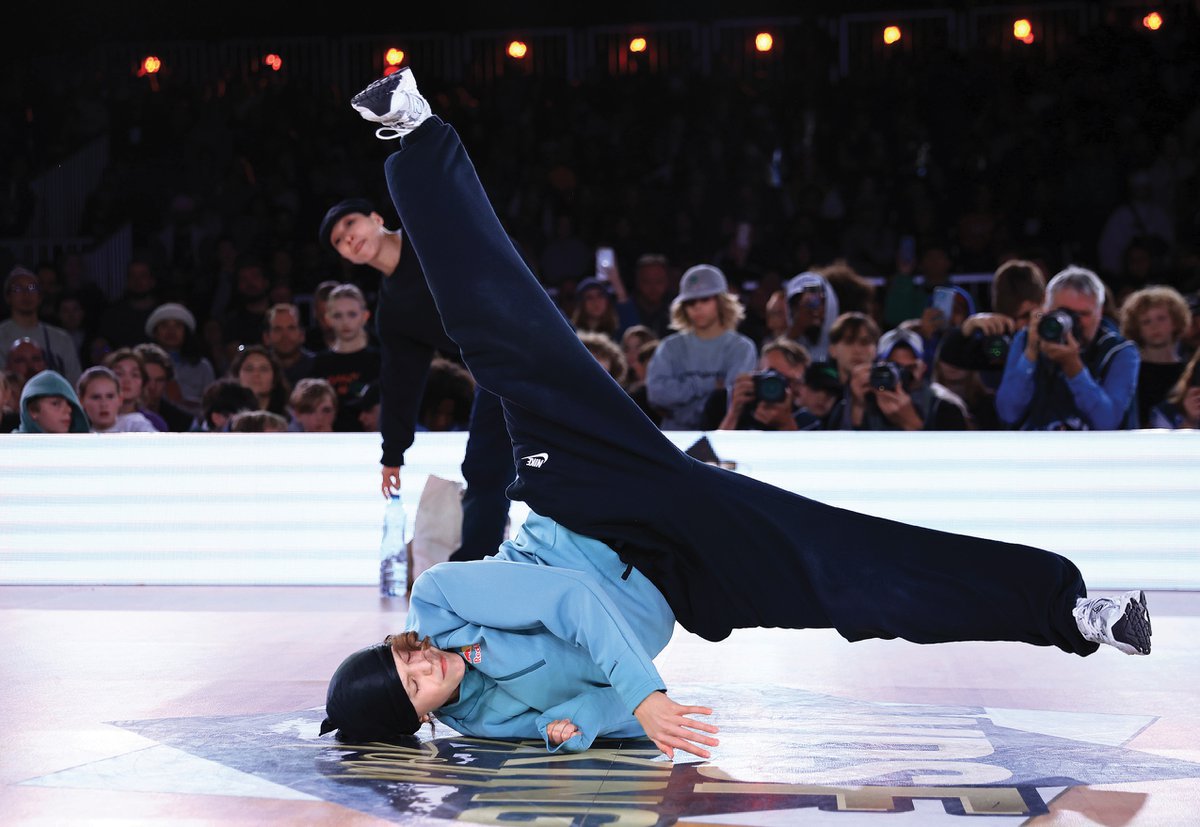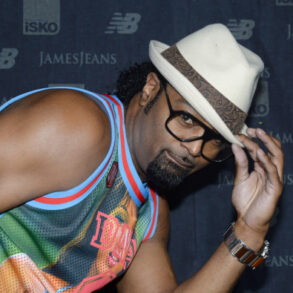
As the world celebrates the fiftieth anniversary of hip-hop this year, the focus has been primarily on the beats and the poetry of rap music. But the cultural movement’s dance component—breaking—is also reaching a historic milestone as dancers prepare for their debut at the 2024 Summer Olympics in Paris.
The first step came in September, as B-girls and B-boys—the gender-specific titles of those who break—from around the world converged on Leuven, Belgium, to battle it out at the 2023 World DanceSport Federation (WDSF) World Breaking Championship for a quota spot at the 2024 Olympics. Among the first to qualify were twenty-nine-year-old Victor “B-Boy Victor” Montalvo, from the United States, and sixteen-year-old Dominika “B-Girl Nicka” Banevič, from Lithuania. In all, thirty-two breakers will compete next summer.
Although this global stage will mark a new pinnacle for the acrobatic dance born on the scrappy streets of the South Bronx, coincidentally, the Olympics is where breaking arrived during its first apex forty years ago, when an army of breakers—including a young Cuba Gooding Jr.—joined Lionel Richie during a performance at the closing ceremony of the 1984 Summer Games in Los Angeles.
Back then, breaking had just detonated into the American mainstream the previous year with the release of the mega-hit film Flashdance. A seventy-second scene of the B-boy troupe Rock Steady Crew dancing on a street corner not only became one of the film’s highlights, it also introduced Americans to this high-powered dance style. Rock Steady Crew members like Ken Swift (Kenneth Gabbert) and Frosty Freeze (Wayne Frost) stunned moviegoers with breaking’s intricate footwork and breathtaking spins on various parts of the body.
“When we were offered to be in the movie, I was completely resistant,” Rock Steady Crew member Marc “Mr. Freeze” Lemberger, who also danced in that trailblazing scene, tells The Progressive. “At the time biting, or copying someone’s move, was absolutely looked down on. And I thought if the world saw us on film, the world was going to bite [our moves].”
Lemberger was right—except the copying led to a revolution. That iconic scene inspired youth nationwide—from the cities to the suburbs—to start breaking, creating an undeniable phenomenon. It was the introduction to hip-hop culture in the United States.
Other breaking crews, such as the New York City Breakers and the Dynamic Rockers, joined Rock Steady in pushing the dance worldwide via appearances in films like Beat Street and Wild Style.
Almost instantly, hip-hop’s dance vocabulary took center stage in every facet of American popular culture. From commercials for McDonald’s to classic television programs like The Cosby Show and Alice, to the New York City Breakers performing at the fiftieth Presidential Inaugural Ball for Ronald Reagan, breaking had come a long way from its origins in the South Bronx.
The dance had developed in New York in the early 1970s, at block parties and park jams thrown by foundational DJs like Kool Herc—considered the father of hip-hop—and Grandmaster Flash. As break beats from records by Baby Huey or James Brown played, neighborhood dancers like Trixie, Rhonda Wingham, Klark Kent, and The Legendary Twins—twin brothers Keith and Kevin Smith, considered the first B-boys—amplified the music’s excitement with awe-inspiring knee-drops, splits, and fancy foot moves.
By the mid-1970s, breaking turned competitive, as crews like the Mighty Zulu Kings—considered the first breaking crew—and Crazy Commandos organized B-boys and girls into dancers who battled against one another. In neighborhoods filled with gangs, these troupes offered a constructive alternative to street organizations and the violence associated with them. Within the fierce competitions, breaking’s vocabulary expanded as dancers added floor moves like freezes, top rocking, leg swipes, and many of the close-to-the-floor maneuvers that became breaking’s foundation.
“I vividly remember people dancing [against each other], disrespecting each other by form of dance,” Lemberger recalls from his days growing up in the Bronx. “One day, a very tall gentleman jumped up in the air, grabbed his knees, and landed on the floor, completely laid out in a pose which we called a freeze.”
At the decade’s end, breaking’s popularity at hip-hop jams began to fade as older teens took to doing disco-inspired dances like the Freak and the Patty Duke, which required a partner—usually of the opposite sex. This left young breaking enthusiasts like Richard Colón without a platform or a means to show off their skills. After Colón, who went by the name Crazy Legs, inherited the Rock Steady Crew, which by then was nearly defunct, he took on the responsibility of finding other youngsters across New York City who still performed the style of dance.
His search led not only to battles with other breakers but also to heavy recruitment as Rock Steady’s ranks were filled with a new generation of dancers eager to get down. Their epic rivalry with the breaking troupe Dynamic Rockers caught the attention of organizers at Lincoln Center, in Manhattan, who, in 1981, invited the two groups to battle at its Out-of-Doors Festival. Coverage of the duel by The New York Times and ABC’s Eyewitness News was among the first to expose breaking to an audience outside of hip-hop’s underground. Two years later, Flashdance released its atomic energy to the rest of the world.
“Seeing ourselves on the big screen was one of the most memorable moments of my life,” Lemberger recalls.
Breaking and its B-boy practitioners became star commodities as the “break dance” craze swept popular culture. Even back then, breaking as an Olympic competition was not out of the question. Shortly after the New York City Breakers appeared on the 1984 NBC special The Stars Salute the U.S. Olympic Teams, their manager, Michael Holman, submitted a petition for the dance to be included in the games.
After all, apart from breaking’s competitive nature, the dance’s arsenal had grown to include—among new eye-popping moves like headspins, windmills, and handspins—gymnastic staples like Kurt Thomas flairs.
With hip-hop’s dance reaching every corner of American life, the possibility seemed real. But breaking’s overexposure in the mainstream and oversaturation in the media—along with a bit of backlash—sent the dance into extinction by 1986.
“Once the mainstream got what it wanted from the dance, all the fascination with breaking and its creativity went out the door,” Lemberger says.
By this point, the commodification of rap music was pushing hip-hop culture further into the mainstream. Breaking may have disappeared from the spotlight, but that made room for other hip-hop dance styles to build from its influence. Funk-sampled rhythms of artists like James Brown and Parliament-Funkadelic—which fueled hip-hop music from the late 1980s into the early 1990s—inspired dances like the Wop, the Biz Markie, Happy Feet, and the Running Man—styles that could be done with a partner or, as many preferred, solo. But even these dances couldn’t escape their hip-hop roots as they were performed competitively and eventually infused with breaking—and a West Coast-invented hip-hop dance called electric boogie—by dancers who were former B-boys.
“Seeing ourselves on the big screen was one of the most memorable moments of my life.” — Marc “Mr. Freeze” Lemberger
Breaking in the United States reemerged in the 1990s via events like the Rock Steady Crew Anniversary, the West Coast’s B-Boy Summit, and reunions of Radiotron, a hip-hop youth center started in the 1980s. But the dancers at these celebrations didn’t just reflect a renewed interest in breaking, but also how—when no one was looking—the dance had gone global.
Amid the multicultural hordes of American breakers were B-boys and girls from places like Australia, Japan, Germany, and Korea. Their interests had been fueled by both footage from breaking’s heyday in the 1980s and the growing network of international street dance festivals like the highly-coveted Battle of the Year, where breakers from around the globe duke it out for world supremacy. Other competitions included the World Battle, Silverback Open Championships, World Breaking Classic, and Red Bull BC One.
Heading into the twenty-first century, this massive worldwide competition injected such explosive creativity within the dance that breaking moves, while always athletic, began defying gravity and anatomy—beyond what seasoned veterans were capable of.
“Let’s just say I can’t do half the moves they’re doing right now,” Crazy Legs told CNN in 2020, “because the evolution of it has gone to such a high level.”
Breaking’s global popularity, albeit mostly underground, created its own branch of youth culture, replete with star dancers, epic battles, and codes of conduct. But was it ready for another shot at the Olympics?
The answer came via the ambitions of the WDSF, an organization recognized by the International Olympic Committee (IOC) that aimed to get competitive dances like ballroom and Latin at the games. After the group hired former IOC veteran Jean-Laurent Bourquin to help them gain traction with Olympic officials, he suggested that, while dance had a shot at the games, the only style the IOC might consider would be breaking. It wasn’t exactly what the WDSF wanted or was prepared for.
“It was a bitter pill for everyone to swallow,” Ken Richards, former WDSF board member, told The Washington Post in 2021.
Another hard truth was that B-girls and boys, who are very protective of breaking’s integrity as an art, didn’t want it to be categorized as a sport. Nor did they want an organization that had no connection to hip-hop or any clue about breaking to take control of the dance or set parameters for how it would be judged competitively.
In 2017, Lebanese Armenian breaker Serouj Aprahamian organized a petition titled “Get the WDSF’s Hands off Hip-Hop.” Aprahamian submitted the petition to the IOC after more than 2,000 people signed it. But the push for the Olympics was already in motion.
Once Bourquin finessed the creation of a breaking category in the 2018 Summer Youth Olympics in Buenos Aires, Argentina (where veteran B-boy Moises Rivas was recruited to help with organizing), the response was undeniable. According to the IOC, the breaking event received more than fifty million social media views, more than any other competition. IOC President Thomas Bach, who had planned to observe the new event for only fifteen minutes, was so riveted by the breakers’ awe-inspiring moves and the crowd’s infectious energy that he stayed the entire time.
Given breaking’s appeal with young people—a demographic the Olympics has been looking to grow—Olympic organizers made their decision. In 2020, the IOC announced breaking would be included in the 2024 Paris Games.
This giant step for breaking was yet another milestone for hip-hop, which had already become the global face of American popular culture. The only dilemma to overcome—as with the WDSF—was building a respectful relationship between Olympic organizers and a street-centered dance with practitioners who were wary of their art form being watered-down.
“At first I was resistant for one reason,” Lemberger says, “because real B-boys, and even veterans of the dance, like myself, weren’t initially asked to be a part of it.”
Press material from the Olympics announcing the new event made breakers suspicious. “One of the first brochures I saw of the breaking program at the Olympics only had white people on it,” Crazy Legs told Insider. “If this dance comes from Black and brown people, why aren’t they in the brochure?”
Since then, the committee has made sure to prominently acknowledge breaking’s Black and Puerto Rican roots. It has also included more photos featuring breakers of color. Olympic committee members have also reportedly met with veteran B-boys like Lemberger to tap their wisdom and hear their concerns.
Despite skepticism within the breaking community, the significance of this history-making development has not been lost on the dancers. “Breaking in the Olympics is an absolutely magnificent thing,” Lemberger says. “It brings the dance to the forefront, and it gives breakers, who’ve spent their lives learning this dance, new opportunities to make a living and do great things to forward this art form of ours.”
His final words of advice?
“My last words to the Olympic committee,” he says, “were, ‘Don’t fuck it up.’ ”
This post was originally published on this site be sure to check out more of their content.





